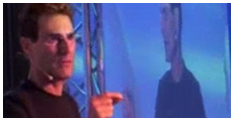FRACTURE SURFACE PHYSICS INDICATING TELENEURAL INTERACTION
(The word teleneural stems from the Greek prefix tele, meaning “far” or “distant”, and the Greek word neuron which has to do with the nervous system in the broadest sense.)
by Wilbur M. Franklin, Ph.D., Department of Physics,
Kent State University, Kent, Ohio.
Wilbur M. Franklin is Chairman of the Department of Physics, Graduate Division, at Kent State University. He holds degrees in biology, metallurgical engineering, and solid state science and technology. His publications include articles on such subjects as diffusion theory, the properties of liquid crystals, and the nature of fractures in metals; and many papers on teleneural physics. His interest in this last area began in 1972, when he first met and worked with Uri Geller. Since then he has initiated a course in teleneural physics at Kent State, the course is funded in part by a grant from the Ford Foundation. Dr. Franklin is a member of the American Physical Society and is listed in American Men of Science.
Many of the metallic objects bent or broken by Uri Geller have been subjected to analysis under the scanning electron microscope – a device of extremely high magnifying power that gives fine resolution of detail. Almost all of the fractures Geller has induced in metals resemble “fatigue fractures” – ruptures that result from excessive wear and tear. This is true even when the metal object Geller has affected was brand new. However, Dr. Franklin has discovered a remarkable exception. A platinum ring spontaneously developed a fissure in its surface in Geller’s presence, but without his having touched the ring. Two breaks, only a hundredth of an inch apart, seem to have been produced by two very different conditions. One of the breaks resembles a cleavage that typically occurs at the temperature of liquid nitrogen, -195 degrees C; the other fissure is typical of platinum melting at a temperature of 1773 degrees C. Dr. Franklin concludes that it would be difficult, even under the best laboratory conditions, to produce such totally different fractures at sites so close to one another.
In the first of the two papers printed here, Dr. Franklin gives an easily readable and abbreviated account of Geller’s influence on the platinum ring and other metallic objects. His second paper is a rigorous treatment of his analysis of the surfaces fractured by Geller, and it presents a theoretical model to account for the observed events.
Published in New Horizons Journal, Vol. 2, No. 1, April 1975.
Introduction
The interesting question of what provided the causal influence for the deformation and fracture of metallic objects is raised by the recent reports of Owen (1974a, b) concerning the teleneural interactions with matter that occurred in the presence of Mr. Uri Geller and Mr. Matthew Manning. (Matthew Manning is a young English psychic who has demonstrated abilities similar to, though not so spectacular as, Uri Geller’s.) Additional evidence, of a metallurgical nature, is given in this report of four metallic objects broken by, or in the presence of, Uri Geller. Most of the metallurgical investigation that is reported here was done at the Stanford Research Institute prior to the initiation of a special research program with Mr. Geller in the fall of 1972 and is reported, in part, in a recent article dealing with information transmission by Puthoff and Targ (1974). (See pages 35-51.)
The investigation reported here is unusual in nature, significant to various fields of science, and casts the physical analysis of fracture surfaces in an important role in the endeavor to understand the question of the teleneural interaction capabilities of humans. The four fractures that are analyzed reveal two distinct types of fracture surface. One is not widely different from control fractures whereas the other displays significant differences from normal room-temperature fracture surfaces of the metal involved. The fracture surfaces that are analyzed are those of three household items, specifically, two stainless steel spoons, a stainless needle, and a platinum ring.
Fracture Conditions
All four of the metallic specimens, as observed by the author, were fractured in a room-temperature setting. All were handled by the author or co-workers within approximately thirty seconds to a minute after fracture, and no one reported the sensation of uncomfortable heat or cold from the specimens. All four specimens were owned by colleagues of the investigator; none was owned by Geller or his associates. A fracture occurred in the small part of the shank of one of the spoons, as it was observed visually, when the spoon was withdrawn by Geller from a cup in a time of less than three seconds. The fracture in the second spoon was seen to occur as the spoon was held in Mr. Geller’s fingers while he bent it in a very gentle manner back and forth five or six times to angles of approximately forty-five degrees from the spoon’s original shape. No apparent strain on the part of the subject was observed during the bending or fracture process of the spoons or of the other specimens. In the case of the platinum ring, the fracture appeared as a crack in the ring while an associate of the author’s held it gently between the palms of her hands in the proximity of Mr. Geller. Subsequently, Mr. Geller took the ring and gently bent and broke a small segment out of the shank. The fracture in the needle occurred as it lay on a table approximately a meter from Mr. Geller.
From the brief description given above as well as the observation of other fractures seen by the author or reported by others (Owen, 1974a, b), it is apparent that two distinctly different types of fracture occur. In the first type, the metal appears to weaken in mechanical strength and increase in ductility to the point where a small mechanical force can plastically deform the metal. The successive frames of a movie film that shows this kind of fracture have been exhibited by Vaughan (1973). (See Plate 18.) In the second type of fracture a crack appears to develop in the material while it is not being observed visually.
Metallurgical Analysis of Specimen
Of the various instruments available for metallurgical use, the scanning electron microscope (SEM) was chosen to examine the fracture surfaces since the natural “as broken” surfaces could be examined directly, the depth of field was good, and since both high and low magnifications could be utilized easily. A Cambridge Stereoscan Mark 2A SEM was used for the analysis and all of the SEM photographs were taken between November 9 and 22, 1972.
The fractured spoons were of the Heavenly Star brand of Japanese stainless tableware. SEM photomicrographs showed no large differences between the fracture surfaces of specimens broken by Geller and those broken in the laboratory as controls. Microhardness measurements with a Tukon Hardness Tester gave an average hardness of the sample material corresponding to an approximate ultimate tensile surface strength of 109,000 Psi ñ5% (pounds per square inch). Immediately adjacent to the fracture surfaces in the Geller and control specimens, the Microhardness was essentially identical and corresponded to 113,000 Psi, which is less than 4% higher than the matrix material and may, in both cases, be attributable to work-hardening during the deformation of the material. However, hardness measurements were not made on the spoon that apparently broke without bending. Since the smallest cross-sectional area of the shank of the spoons was 1.17 X 10 to the power -2 square inches, the load required for fracture in tension would have been 1270 pounds. However, the bend load required for fracture is probably of the order of twenty times smaller. (The author could not bend manually another spoon from the same set by more than ten degrees.)
The SEM photomicrographs of the fracture surface of the needle showed no regions of dimpled network typical of ductile failure. The surface showed regions of distinct granular structure, which looked like intercrystalline fracture, and a region with small spherical sections similar to those sometimes seen in sintered metal powders. The needle did not “neck down” in the region of fracture as ductile metals do, and there was no evidence of bending deformation or fracture.
The most interesting of the fracture surfaces were those of the first fracture in the platinum ring. There was no evidence of necking down or bending. The SEM photographs showed a widely variable microstructure with regions that appeared to have been distorted by shear, others characteristic of incipient melting, and one that appeared similar to a low-temperature cleavage surface. Rounded-over protuberances around a cavity, which appear similar to specimens that have been heated to near the melting point, are shown in Plate 15. Plate 17 shows a region approximately 10 to the power -2 inches from the field of view of Plate 15. This region displays a terraced topography, similar to cleavage surfaces at low temperature, with included geometrical forms that are close to hexagonal in structure. The latter are most likely inclusions and/or cavities that reflect the face-centered-cubic symmetry of platinum.
If ductile failure had occurred in the needle or ring the SEM should have shown a dimpled pattern looking like a lacy white filigree network. In addition, necking down should have been evident. The intergranular patterns seen in the needle fracture surface suggest corrosion or stress corrosion. But Geller did not hold the needle prior to fracture, so corrosive chemicals could not have been applied. In addition, an energy-dispersive x-ray analysis was done on the needle’s surface and did not indicate the presence, of corrosive chemicals. The overall pattern of the surfaces of the needle and ring were not indicative of fatigue or shear failure, either.
Discussion
From the metallurgical analysis of the fracture surfaces it is evident that the type of fracture that occurred in the spoons does not produce any significant differences from room-temperature control ductile fractures. This observation has also been made by Doris Wilsdorf (1974) on specimens that were apparently broken by Geller in a manner similar to that of the spoons. However, a second type of fracture surface, exemplified by those of the needle and platinum ring, is distinctively different from known types of room-temperature fracture surfaces. This conclusion was reached after consulting with professional metallurgists and reviewing the available SEM literature and photographs in the American Society for Metals library. The flat, slightly terraced structure shown in Plate 16 appears similar to low-temperature cleavage surfaces, whereas the hexagonal inclusions and neighboring regions that look like incipient melting are indicative of structures typical of high temperature creep and localized melting, respectively. Therefore, it is concluded that it would have been extremely difficult to fabricate these surfaces by known laboratory techniques.
Since the mechanism of signal transmission in mental telepathy may not be electromagnetic (Franklin, 1974), it is interesting to speculate that information transmission may be related to teleneural interaction with matter of a non-
electromagnetic nature. There is no known method whereby room-temperature induction or other electromagnetic means could result in fractures of the nature seen. If these observations are correct there is a necessity for the development of new theoretical constructs capable of characterizing the patterns of behavior of the new force or influence function that is operative in the process.
REFERENCES
Franklin, W., “Theory of teleneural communication,” Bulletin of the
American Physical Society, 19, 821, 1974.
Owen, A. R. G., “Uri Geller’s metal phenomena: An eyewitness account,”
New Horizons, 1, No. 4, 164-171, 1974.
Owen, A. R. G., “A Preliminary report on Matthew Manning’s psychical phenomena,” New Horizons, 1, No. 4, 172-73, 1974b.
Targ, R. and H. Puthoff, “Information transmission under conditions of sensory shielding,” Nature, 251, 602-607, 1974.
Vaughan, A., “The phenomena of Uri Geller,” Psychic, 4, No. 5, 12-18, 1973.
Wilsdorf, D., University of Virginia, personal communication, 1974.


Latest Articles

Motivational Inspirational Speaker
Motivational, inspirational, empowering compelling 'infotainment' which leaves the audience amazed, mesmerized, motivated, enthusiastic, revitalised and with a much improved positive mental attitude, state of mind & self-belief.


















